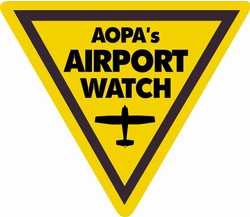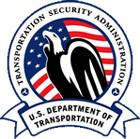AOPA's Initiative Helps Protect Nation's General Aviation
Airports
 The Aircraft Owners and Pilots Association has
formally unveiled AOPA's Airport Watch, a program to enhance
security at general aviation (GA) airports across the country.
Airport Watch is patterned after the highly-successful neighborhood
watch anti-crime programs, which call on community members to note
and report suspicious activity. Some 700,000 pilots and airport
workers are being asked to participate in Airport Watch programs at
5,000 GA airports.
The Aircraft Owners and Pilots Association has
formally unveiled AOPA's Airport Watch, a program to enhance
security at general aviation (GA) airports across the country.
Airport Watch is patterned after the highly-successful neighborhood
watch anti-crime programs, which call on community members to note
and report suspicious activity. Some 700,000 pilots and airport
workers are being asked to participate in Airport Watch programs at
5,000 GA airports.
The Transportation Security Administration (TSA) and AOPA have
partnered to deploy this national security-enhancement program.
"General aviation pilots are eager to do their part for national
security," said AOPA President Phil Boyer. "One of the best things
we can do is be the eyes and ears for law enforcement in our own
neighborhood — the GA airport. Who is going to know better
than a pilot what looks like normal activity and what doesn't, who
belongs and who doesn't?"
Homeland Security Secretary Tom Ridge has called Airport Watch
"... a great example of government and the private sector working
together to secure the homeland."
"Keeping our airports safe in this free and welcoming nation is
an enormous challenge," he said. "We all must watch out for one
another. Airport Watch can help."
 AOPA's Airport Watch was developed in consultation
with the Transportation Security Administration and other law
enforcement agencies. TSA is providing a key element for the
success of the program — a national, toll-free security
hotline and centralized reporting system for collecting information
from pilots and quickly dispersing it to the appropriate law
enforcement agencies.
AOPA's Airport Watch was developed in consultation
with the Transportation Security Administration and other law
enforcement agencies. TSA is providing a key element for the
success of the program — a national, toll-free security
hotline and centralized reporting system for collecting information
from pilots and quickly dispersing it to the appropriate law
enforcement agencies.
"We appreciate AOPA's proactive approach to enhance security for
the general aviation community," said Under Secretary of
Transportation for Security James M. Loy (right). "It makes
sense that the world's largest civil aviation organization would
offer their expertise for the collective effort in the war on
terrorism."
Airport Watch is an integrated program to educate and involve
pilots in security AOPA's Airport Watch is an integrated program to
educate and involve pilots in enhancing general aviation security.
Since the 9/11 attacks, AOPA has used its media outlets to educate
pilots about security issues and to encourage pilot vigilance at
airports. AOPA media (AOPA Pilot and AOPA Flight
Training magazines, AOPA ePilot email newsletter, and the AOPA
Web site, www.aopa.org) reach the
vast majority of the nation's pilots.
AOPA is building on that communication base with a series of
Airport Watch materials. To date, AOPA has committed almost half a
million dollars to the production and distribution of Airport Watch
materials.
Airport Watch Brochure Sent to Every U.S. Pilot
 In December, AOPA sent the Airport Watch brochure
to each of its more than 393,000 members. TSA will send copies to
the remaining pilots who are not members of AOPA, while the
Professional Aviation Maintenance Association will
send it to aviation mechanics and technicians. Other aviation
organizations will be distributing the brochure as well.
In December, AOPA sent the Airport Watch brochure
to each of its more than 393,000 members. TSA will send copies to
the remaining pilots who are not members of AOPA, while the
Professional Aviation Maintenance Association will
send it to aviation mechanics and technicians. Other aviation
organizations will be distributing the brochure as well.
Keep your eyes open.
The brochure points out some of the things pilots should be on
the lookout for at airports: pilots who appear to be under the
control of others; anyone trying to access an aircraft through
force; anyone who seems unfamiliar with aviation procedures trying
to rent an aircraft; aircraft with unusual or obviously
unauthorized modifications.
It cautions pilots to follow their gut instincts but use common
sense. None of the items listed necessarily indicates terrorist
activities. The brochure includes a tear-out checklist of what
pilots should watch for and report.
"The goal here is to raise awareness," said Boyer (above,
right). "It's not to spread paranoia."
With the brochure, pilots also received a window decal to
display on their planes declaring that this aircraft is part of
AOPA's Airport Watch.
Airport Watch Video Offers Examples of What to Look For
 AOPA has produced a videotape to help pilot
organizations and other airport groups learn what to watch and
listen for. Phil Boyer introduces a number of scenarios that depict
suspicious activities that may warrant a call to authorities.
AOPA has produced a videotape to help pilot
organizations and other airport groups learn what to watch and
listen for. Phil Boyer introduces a number of scenarios that depict
suspicious activities that may warrant a call to authorities.
"The September 11 terrorists were from the Middle East, but the
next terrorists could be from anywhere and look like your next-door
neighbor," Boyer says on the tape. "And that's the point. There is
no terrorist 'type.' Terrorists won't always speak with an accent
or look a certain way. It's what they're doing and how they're
acting that should make you suspicious."
The videotape was produced in consultation with TSA and with
local law enforcement agencies. To add realism to the training
tape, in one of the scenarios police officers and dispatchers
enacted their roles as they would in responding to a real call
reporting possible terrorist or criminal activity.
Scenarios range from obvious situations like pilots being
waylaid and coerced aboard corporate jets, to shady characters
trying to force their way into aircraft or hangars, to more subtle
situations like someone asking questions that are almost (but not
quite) right. There's even one scenario that appears to be
suspicious but is in fact benign.
The video is free upon request and can also be viewed on the
AOPA Web site at www.aopa.org/airportwatch/.
It will be distributed to pilot and airport groups across the
country, including the 800 local chapters of the Experimental
Aircraft Association (EAA).
The video will be shown at the hundreds of FAA and AOPA Air
Safety Foundation safety seminars conducted nationwide. It will
also be incorporated into the Air Safety Foundation's Flight
Instructor Refresher Clinics, ensuring that flight instructors are
spreading the word to the pilot community.
TSA Provides 1-866-GA-SECURE: Airport Watch Hotline
One of the keys to making Airport Watch work is having an easy
way for pilots to report their suspicions, no matter where they may
be flying. At AOPA's request, TSA has provided an easy-to-remember
nationwide toll-free hotline (866-GA-SECURE or 866-427-3287) for
pilots to use.

TSA activated the hotline December 2, 2002. It is staffed 24/7
by U.S Coast Guard personnel at the National Response Center. Based
on the information a pilot gives them about a possible threat, they
are able to contact all the appropriate authorities in that
airport's community. The toll-free hotline number will be displayed
prominently on warning signs and posters at thousands of GA
airports.
 AOPA has distributed kits, including the signs,
posters, videos, and brochures to AOPA Airport Support Network
volunteers at 1,400 airports, to airport managers and directors at
another 3,500 airports, and to 150 TSA federal security directors,
as well as aviation directors in all 50 states.
AOPA has distributed kits, including the signs,
posters, videos, and brochures to AOPA Airport Support Network
volunteers at 1,400 airports, to airport managers and directors at
another 3,500 airports, and to 150 TSA federal security directors,
as well as aviation directors in all 50 states.
"The Transportation Security Administration has rightly been
focused on the air carrier airports, where large passenger aircraft
like the ones used in the September 11 attacks operate," said
Boyer. "We, the general aviation pilots in this country, have an
obligation to help secure our airports and our skies. By keeping
our eyes and ears open, we can play a vital role in our national
security."
 ANN's Daily Aero-Linx (04.13.24)
ANN's Daily Aero-Linx (04.13.24) ANN's Daily Aero-Term (04.13.24): Beyond Visual Line Of Sight (BVLOS)
ANN's Daily Aero-Term (04.13.24): Beyond Visual Line Of Sight (BVLOS) Airborne 04.09.24: SnF24!, Piper-DeltaHawk!, Fisher Update, Junkers
Airborne 04.09.24: SnF24!, Piper-DeltaHawk!, Fisher Update, Junkers Aero-News: Quote of the Day (04.14.24)
Aero-News: Quote of the Day (04.14.24) ANN's Daily Aero-Term (04.14.24): Maximum Authorized Altitude
ANN's Daily Aero-Term (04.14.24): Maximum Authorized Altitude








